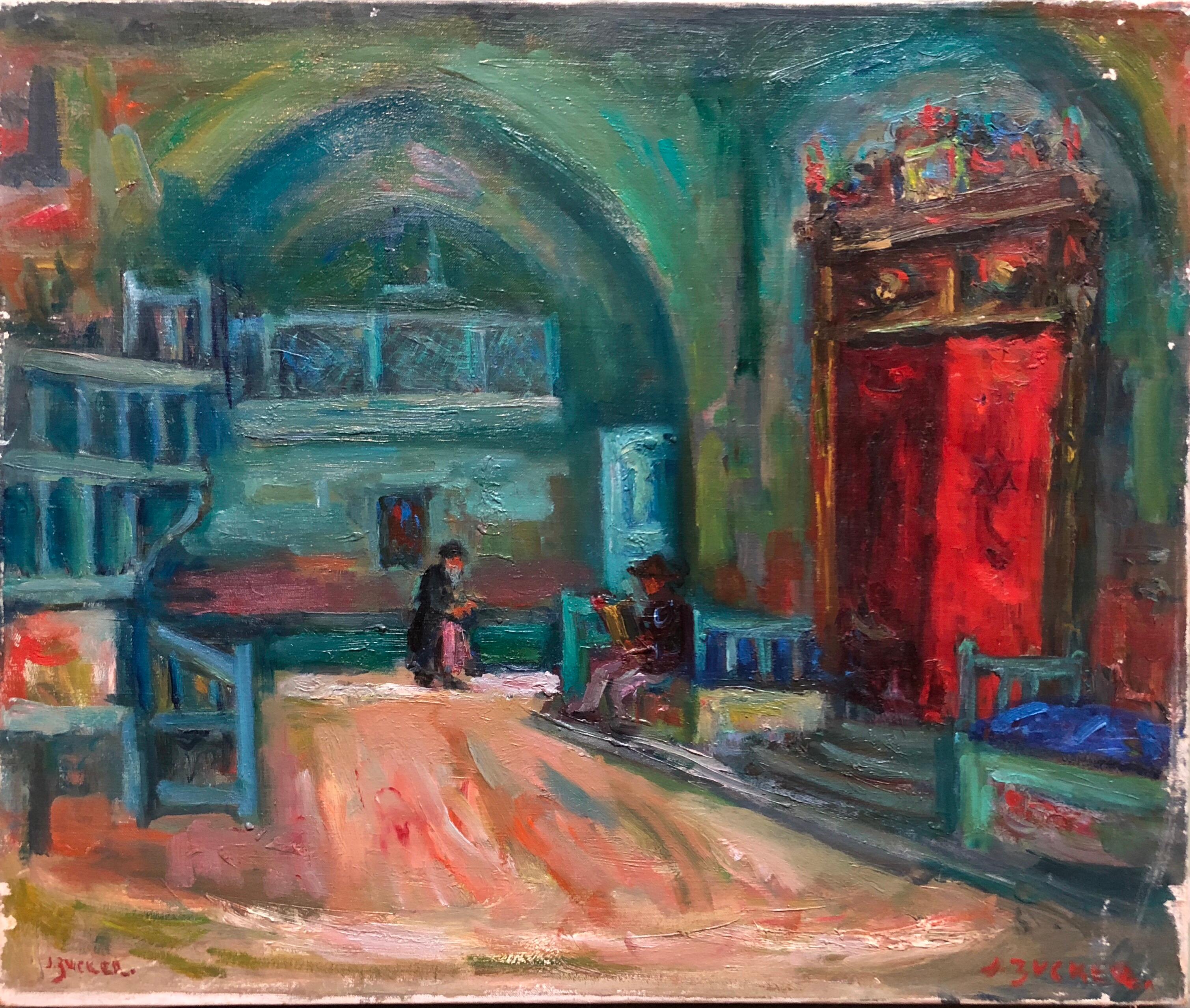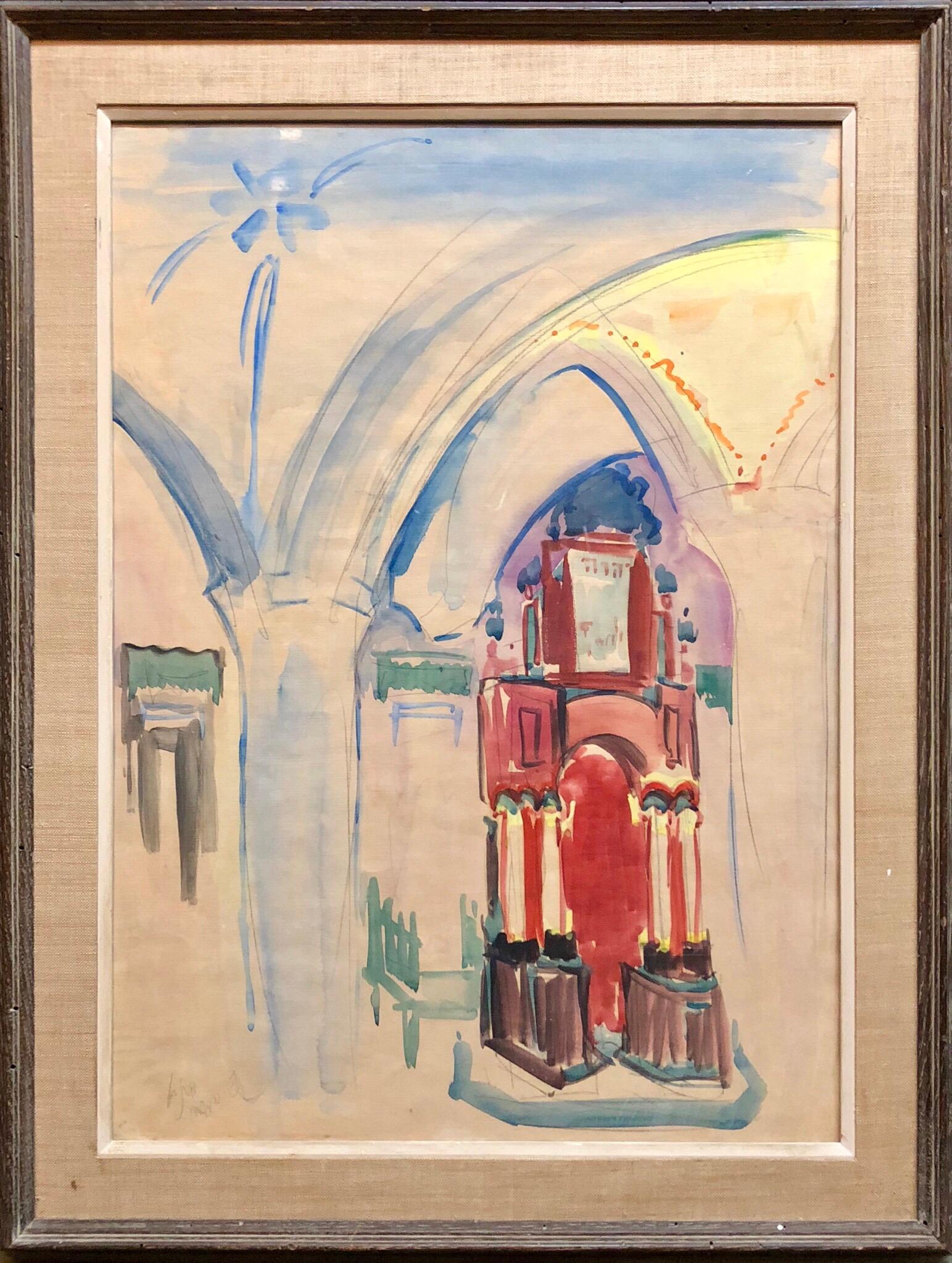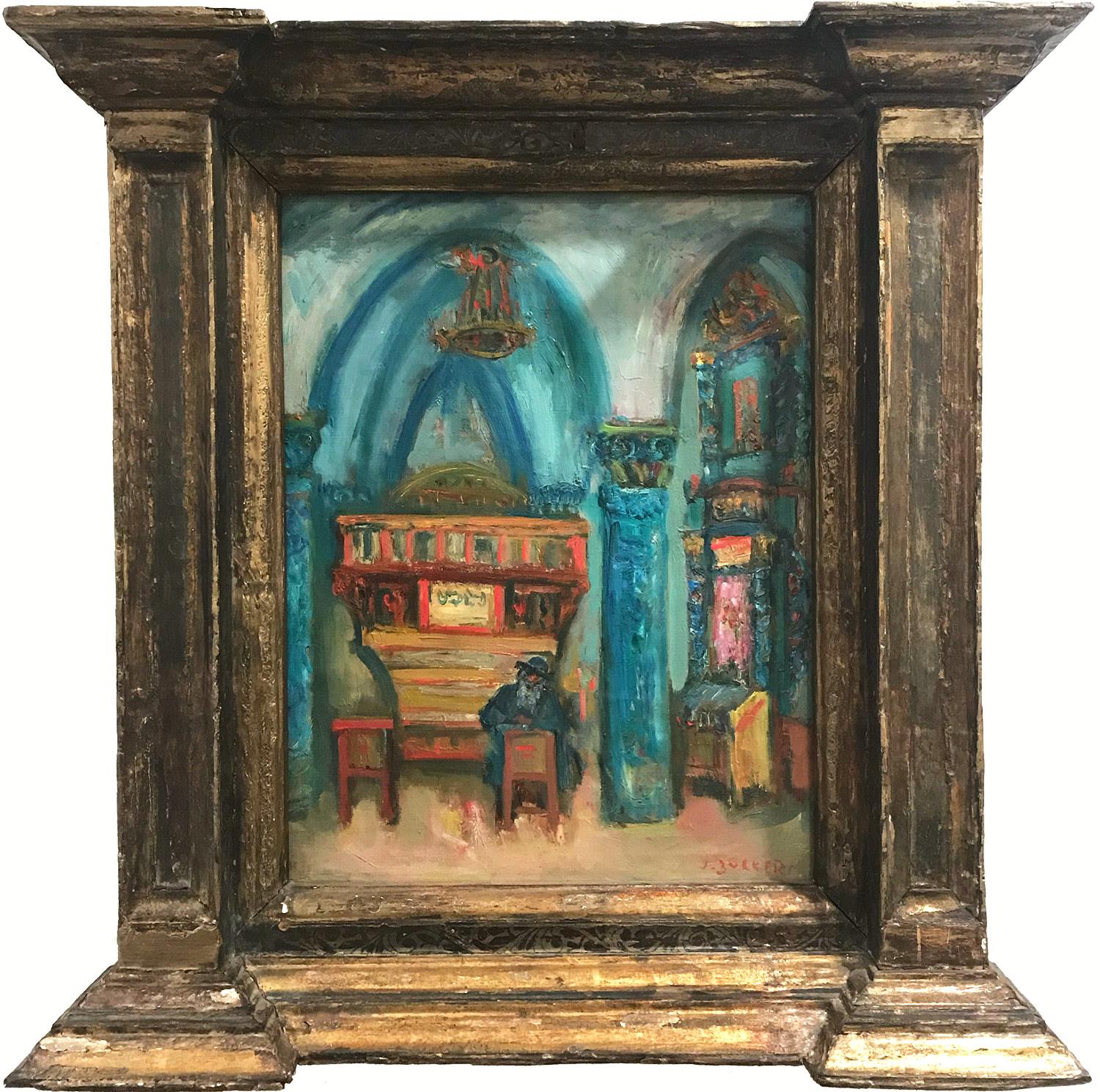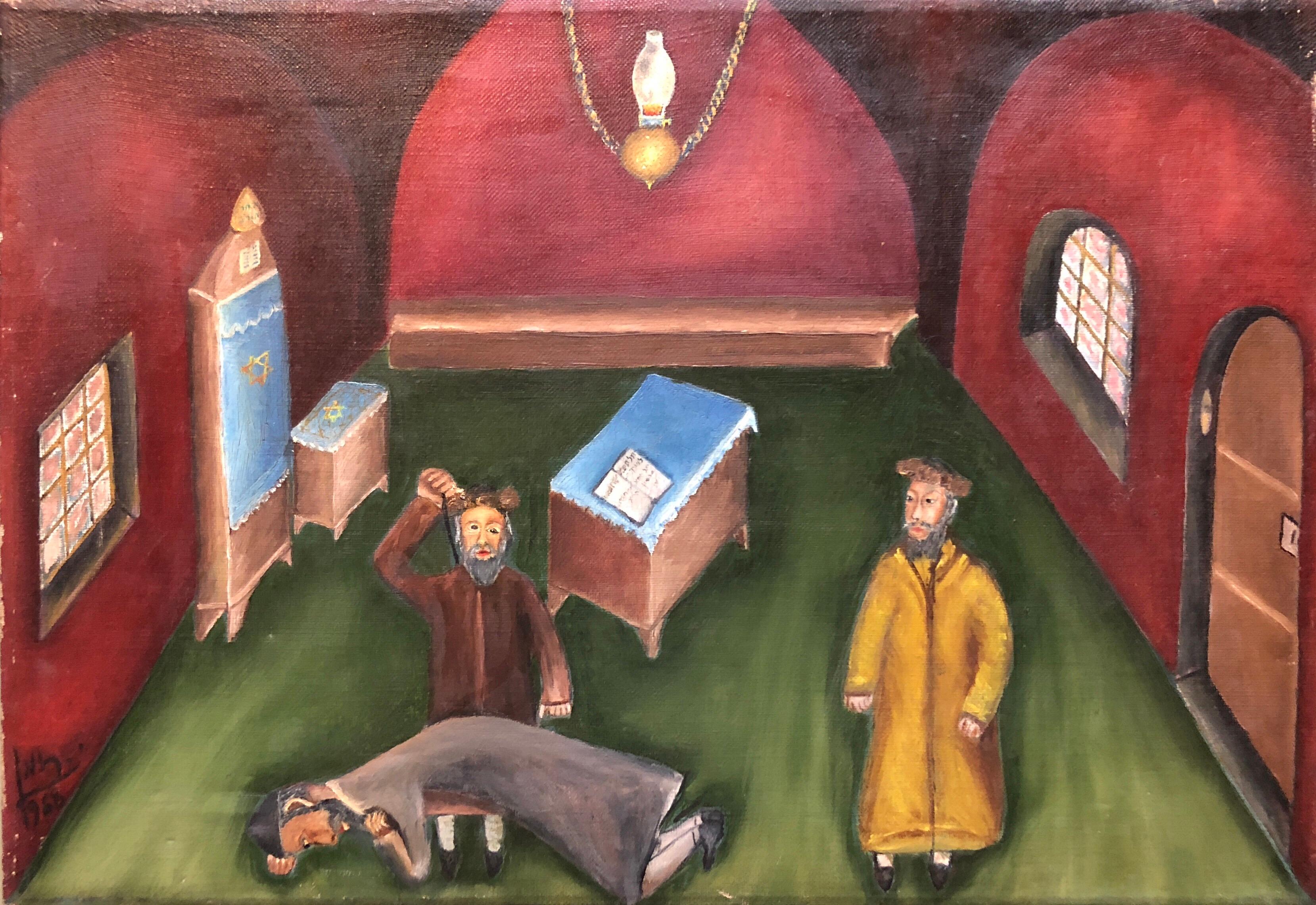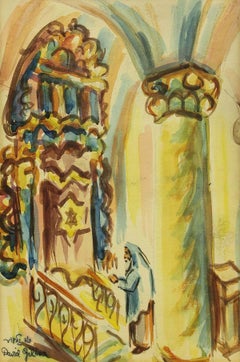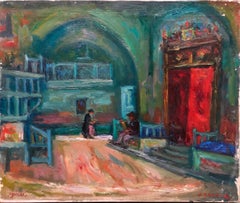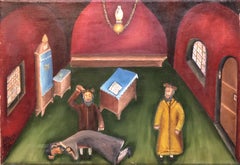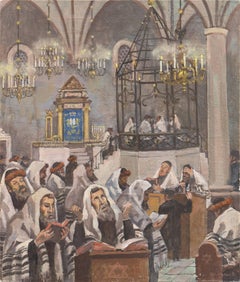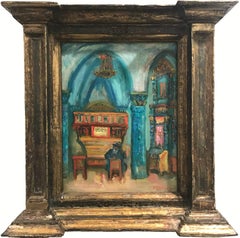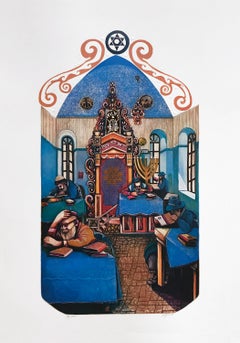Items Similar to Old Synagogue in Safed Israel
Want more images or videos?
Request additional images or videos from the seller
1 of 7
Raphael PricertOld Synagogue in Safed Israel1956
1956
$1,250
£965.84
€1,116.60
CA$1,766.34
A$1,981.07
CHF 1,037.45
MX$24,071.91
NOK 13,173.94
SEK 12,489.82
DKK 8,334.87
About the Item
Framed Judaica oil painting of architecture interior of synagogue in Tzfat, Safed, Israel: by Raphaël Pricert. Born in 1903, Raphael Pricert is a listed Russian born Impressionist painter who trained in Bucharest, Odessa, Italy and Paris. His works were exhibited widely in Europe as well as in the United States. In San Francisco, he was represented by the prestigious Maxwell Galleries. He died in 1967.
- Creator:Raphael Pricert (French)
- Creation Year:1956
- Dimensions:Height: 19.5 in (49.53 cm)Width: 17.5 in (44.45 cm)
- Medium:
- Period:
- Condition:
- Gallery Location:Surfside, FL
- Reference Number:1stDibs: LU38211327642
About the Seller
4.9
Platinum Seller
Premium sellers with a 4.7+ rating and 24-hour response times
Established in 1995
1stDibs seller since 2014
1,787 sales on 1stDibs
Typical response time: <1 hour
- ShippingRetrieving quote...Shipping from: Surfside, FL
- Return Policy
Authenticity Guarantee
In the unlikely event there’s an issue with an item’s authenticity, contact us within 1 year for a full refund. DetailsMoney-Back Guarantee
If your item is not as described, is damaged in transit, or does not arrive, contact us within 7 days for a full refund. Details24-Hour Cancellation
You have a 24-hour grace period in which to reconsider your purchase, with no questions asked.Vetted Professional Sellers
Our world-class sellers must adhere to strict standards for service and quality, maintaining the integrity of our listings.Price-Match Guarantee
If you find that a seller listed the same item for a lower price elsewhere, we’ll match it.Trusted Global Delivery
Our best-in-class carrier network provides specialized shipping options worldwide, including custom delivery.More From This Seller
View AllSynagogue Interior Safed, Israel
By David Gilboa
Located in Surfside, FL
David Gilboa (1910-1976). David Gilboa was born in Romania in 1910. He studied at Academy of Fine Art, Bucharest, Romania, during the years of 1927-29. He immigrated to Israel in 193...
Category
20th Century Modern Drawings and Watercolor Paintings
Materials
Watercolor
Synagogue Interior Jerusalem French Judaica Oil Painting Israeli Bezalel School
By Jacques Zucker
Located in Surfside, FL
Genre: Post Impressionist
Subject: Landscape
Medium: Oil
Surface: Canvas
Country: France
Dimensions: 24" x 20"
Jacques Zucker was born in 1900 in Radom, Poland. He was a notably famous Jewish American artist mostly known for his expressionist figure paintings. In his young years he traveled to Palestine to study fine arts at the Bezalel Art School in Jerusalem. In 1917 he joined the British Royal Fuesiliers under the leadership of General Allenby to liberate Palestine from the Turks. After the first World War he settled in Paris, where he continued his studies at Académie Julian and Academie Colarossi. He then emigrated to the United States in 1922 and continued his art studies at the National Academy of Design. He supported himself by designing jewelry. In 1925 he returned to Paris and studied at the Academie de la Grande Chaumier et Colarossi. During the Depression he worked for the WPA. From 1928 he took part in the Paris Salons: Autumn and the Tuileries. His works are expressionistic variations in the type of the Ecole de Paris. As a protégé of both Chaim Soutine and Renoir, hints of their style can be observed in much of his own work. Zucker’s style, that may have been influenced from the art of artists such as Marc Chagall, took pride in being an “internationalist”, standing the art of painting in its highest expression is universal no matter where the canvas was created. People who respond to quality in art will understand the beauty and meaning, in their own land or in a foreign land, this was his main idea behind his artworks that was exhibited in numerous solo show in leading galleries and museums in New York, Paris, Tel Aviv, and other art centers. Claude Roger-Marx of Figaro Litteraire, dean of French art critics, write a comprehensive study of Zucker’s illustrated with 135 color and black and white plates. He traveled widely, including Italy, Spain, Portugal, Mexico and Israel. From then on Zucker lived alternately in New York and Paris, maintaining homes in both places, and spent considerable time painting in Mexico, Portugal, Greece, and Israel. Zucker's post-impressionist works including town and landscapes, still-lives, and portraits, are part of an array of permanent installments in numerous museums and private collections in Tel Aviv, including the Joseph Hirschorn collection in Washington, D. C., the Museum of Modern Art in Paris, and the Bezalel Art Museum in Jerusalem. In 1947 he settled in Arcueil near Paris. Zucker died in 1981 in New York.
The School of Paris, Ecole de Paris, was not a single art movement or institution, but refers to the importance of Paris as a center of Western art in the early decades of the 20th century. Between 1900 and 1940 the city drew artists from all over the world and became a centre for artistic activity. School of Paris was used to describe this loose community, particularly of non-French artists, centered in the cafes, salons and shared workspaces and galleries of Montparnasse. Before World War I, a group of expatriates in Paris created art in the styles of Post-Impressionism, Cubism and Fauvism. The group included artists like Pablo Picasso, Marc Chagall, Amedeo Modigliani and Piet Mondrian. Associated French artists included Pierre Bonnard, Henri Matisse, Jean Metzinger and Albert Gleizes.
The term "School of Paris" was used in 1925 by André Warnod to refer to the many foreign-born artists who had migrated to Paris. The term soon gained currency, often as a derogatory label by critics who saw the foreign artists—many of whom were Jewish—as a threat to the purity of French art. Art critic Louis Vauxcelles, noted for coining the terms "Fauvism" and "Cubism", Waldemar George, himself a French Jew, in 1931 lamented that the School of Paris name "allows any artist to pretend he is French. it refers to French tradition but instead annihilates it.
The artists working in Paris between World War I and World War II experimented with various styles including Cubism, Orphism, Surrealism and Dada. Foreign and French artists working in Paris included Jean Arp, Joan Miro, Constantin Brancusi, Raoul Dufy, Tsuguharu Foujita, artists from Belarus like Michel Kikoine, Pinchus Kremegne, and Jacques Lipchitz, the Polish artist Marek Szwarc and others such as Russian-born prince Alexis Arapoff.
A significant subset, the Jewish artists, came to be known as the Jewish School of Paris or the School of Montparnasse. The core members were almost all Jews, and the resentment expressed toward them by French critics in the 1930s was unquestionably fueled by anti-Semitism. Jewish members of the group included Emmanuel Mané-Katz, Chaim Soutine, Adolphe Féder, Chagall, Moïse Kisling, Maxa...
Category
Mid-20th Century Post-Impressionist Landscape Paintings
Materials
Canvas, Oil
Israeli Modernist Watercolor Painting Safed Synagogue Interior Bezalel School
By Mordechai Avniel
Located in Surfside, FL
Watercolor painting of Shul interior in Tzfas, Safed Israel.
MORDECHAI AVNIEL
Minsk, Belarus, b. 1900, d. 1989
Mordecai Dickstein (later Avniel) was born in 1900 in Minsk, present-day Belarus. He studied fine arts in Yekaterinburg, Russia (1913–19) and at the Bezalel Academy of Art and Design, Jerusalem (1923). Avniel immigrated to Palestine in 1921 where he first worked as a pioneer in citrus plantations near Petah Tikva. In 1923, at the urging of Boris Schatz, he went to Jerusalem to further his art studies at Bezalel. He later taught painting and sculpture at the school, and served a term as director of the Small Sculpture Section of the Sculpture Department (1924–28). From 1935 on, Avniel lived in Haifa. Avniel was also a lawyer and a founding partner of the Haifa firm Avniel, Salomon & Company.
Avniel regularly showed his work in group exhibitions of the Painters and Sculptors' Association of Israel. He was awarded the Herman Struck Prize (1952), Tenth Anniversary Prize for Watercolours, Ramat Gan (1958), Histadrut Prize (1961), and First Prize Haifa Municipality (1977). He represented Israel at the 1958 Venice Biennale and the 1962 International Art Seminar at Fairleigh Dickinson University. Avniel was a member of the Artists' Colony in Safed and maintained a studio on Mount Carmel.
Mordechai Avniel is best known for his deft and singular landscape work.
His works are held in numerous museums and collections both in Israel and abroad, including the Metropolitan Museum, New York and the Carnegie Institute, Pittsburgh, PA. Avniel's manipulations of light and colour share much with those of compatriot artists Shimshon Holzman and Joseph Kossonogi.
Education
1913-19 Art School of Katrinburg, Russia
1923 Bezalel School of Art, Jerusalem
Selected exhibitions:
2004: Our Landscape: Notes on Landscape Painting in Israel, University of Haifa Art Gallery, Haifa (online catalogue)
1965: Mordechai Avniel Retrospective, Haifa Municipality Museum of Modern Art, Haifa
1964: Galerie Synthèse, Paris
1962: New York University, New York
1961: Rina Gallery of Modern Art, Jerusalem
The Autumn Exhibition Rina Gallery, Jerusalem
Artists: Dedi Ben Shaul...
Category
20th Century Modern Interior Paintings
Materials
Paper, Watercolor
Israeli Judaica Folk Art Oil Synagogue Interior Malkos Lashes Erev Yom kippur
By Yitzchak Roman
Located in Surfside, FL
Yitzchak Roman, Israeli Folk Artist Painting and sculpture, born in Safed, 1913, known for his naive depictions of Jewish life and biblical scenes...
Category
20th Century Modern Figurative Paintings
Materials
Canvas, Oil
Synagogue Interior Jerusalem Modernist Israeli Judaica Oil Painting Rabbi Prayer
By Arieh Allweil
Located in Surfside, FL
ARIEH ALLWEIL (ARIE ALWEIL) 1901-1967
Galicia 1901-1967 Safed, Israel (Ukrainian/Polish/Israeli)
Arieh Allweil, born 1901, Galicia. Immigrated to Palestine in 1920. Studies: 1921-25...
Category
20th Century Modern Figurative Paintings
Materials
Canvas, Oil, Board
Modernist American Judaica Painting Synagogue Interior Ladies Section WPA Era
By Ervin B. Nussbaum
Located in Surfside, FL
Titled Torah Service, hand signed on Arches archival paper.
In this painting, Nussbaum portrays a joyful holiday celebration of the Torah reading in the synagogue in a sketch-like m...
Category
20th Century Modern Figurative Paintings
Materials
Gouache
You May Also Like
'Interior of Synagogue with Rabbi', Polish Orthodox Judaica, Israel, Pentateuch
By Mieczyslaw Watorski
Located in Santa Cruz, CA
Signed lower right, 'M. Watorski' for Mieczyslaw Watorski (Polish, 1903 - 1979) and painted circa 1950.
This Polish history and landscape painter is particularly revered for his doc...
Category
1940s Modern Interior Paintings
Materials
Canvas, Oil
"Synagogue Interior Scene with Figure" Post-Impressionist Oil Painting on Canvas
By Jacques Zucker
Located in New York, NY
An outstanding oil painting depicting a religious figure seated in a Synagogue with decorated columns and in between arches. The bright colors and quick brush strokes are what make t...
Category
20th Century Post-Impressionist Figurative Paintings
Materials
Canvas, Oil
View of Safed
By Mordechai Levanon
Located in London, GB
MORDECHAI LEVANON 1901-1968
Romania 1901 – 1968 Israel (Israeli/ Romanian)
Title: View of Safed
Technique: Original Oil on Paper laid on Canvas
Size: 70.3 x...
Category
Mid-20th Century Paintings
Materials
Canvas, Oil
YASHIVA IN JERUSALEM (JUDAICA ART)
By Amram Ebgi
Located in Aventura, FL
Embossed lithograph with foil stamping on paper. Hand signed and numbered by the artist. From the edition of 300.
Artwork is in excellent condition. Certificate of authenticity in...
Category
Late 20th Century Contemporary Figurative Prints
Materials
Foil
$100 Sale Price
50% Off
Streets of Jerusalem
By Manobla
Located in Fort Washington, PA
Medium: Oil on Sculpted Composition
Dimensions: 17.50" x 13.50"
Signature: Signed Lower Left
A Jerusalem Gate at night
Category
Mid-20th Century Interior Paintings
Materials
Oil
Volodymyr's Cathedral_
Located in Edinburgh, GB
Written based on sketches from the Volodymyr Cathedral in Kyiv
Category
Early 2000s Impressionist Interior Paintings
Materials
Canvas, Oil

